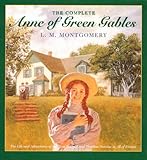This guest post was written by Amy Puetz. A homeschool graduate, she loves history, sewing, and working as a computer graphic artist for her company A to Z Designs. In her spare time she enjoys traveling to different historical eras via books and movies! A columnist for Homeschool Enrichment Magazine, she also writes for her series of e-books, Heroines of the Past.
Visit her website at www.AmyPuetz.com.
“You can ask Diana to come over and spend the afternoon with you and have tea here.”
“Oh, Marilla!” Anne clasped her hands. “How perfectly lovely! You ARE able to imagine things after all or else you’d never have understood how I’ve longed for that very thing. It will seem so nice and grown-uppish. No fear of my forgetting to put the tea to draw when I have company. Oh, Marilla, can I use the rosebud spray tea set?”
“No, indeed! The rosebud tea set! Well, what next? You know I never use that except for the minister or the Aids. You’ll put down the old brown tea set. But you can open the little yellow crock of cherry preserves. It’s time it was being used anyhow-I believe it’s beginning to work. And you can cut some fruit cake and have some of the cookies and snaps.”
“I can just imagine myself sitting down at the head of the table and pouring out the tea,” said Anne, shutting her eyes ecstatically. “And asking Diana if she takes sugar! I know she doesn’t but of course I’ll ask her just as if I didn’t know. And then pressing her to take another piece of fruit cake and another helping of preserves. Oh, Marilla, it’s a wonderful sensation just to think of it.”
This scene from Anne of Green Gables by L. M. Montgomery is a good example of the importance of Victorian Tea Time. Tea time in Victorian society was usually a light meal eaten between breakfast in the morning and dinner in the evening. The typical hour was four o’clock. Drinking tea was not limited to one meal a day. It was also consumed at breakfast and dinner. During afternoon tea ladies would have cold meat, bread (such as rusk, crumpets, biscuits, etc.) and some kind of fruit (either preserves, stewed apples, or jellys). Traditionally either green or black tea was served. It was common to offer both if the preferred beverage was not known. Victorian ladies also enjoyed afternoon tea parties. Friends would be invited and tea time would be shared with a group.
Tea would be served with sugar and milk. For many families tea was the final meal of the day. Breakfast was eaten early, dinner was consumed at noon and then tea was in the late afternoon. There was great variety among individuals when lunch, dinner, supper, and tea were taken depending on a person’s wealth and work schedule. Although tea was a popular beverage before the Victorian era we get many of our traditions from them, such as the practice of having afternoon tea! Here are some good cookbooks about Victorian food.
To end I must tell you about Anne Shirley’s tea party. Before the actual tea Anne served Diana some raspberry cordial and Diana soon became very sick. Apparently it was currant wine and not raspberry cordial that Anne gave her guest. Perhaps she should have supplied tea, instead!
Tea Party Girl’s note: At what age did you first read Anne of Green Gables? Did you have a bosom friend in junior high? My kindred spirit was also red-haired and now makes movies for a living, having married an Italian filmmaker. She was definitely the Anne Shirley to my Diana Barry, with her rich imagination. Tell us about yours in the comments below.



This is a great post – very informative and charming! I remember reading Anne of Green Gables in high school. :o) Now I am in the mood for afternoon tea…
I enjoyed this post.
I did not read Anne until I was over 40…I did discover the PBS presentation when my children (4 boys) were in elementary and junior high. I had it on tape and they remember watching it several times because I was watching it. Even though they pretended they were “forced” and would not admit it at the time…they and my husband enjoyed it.
I was introduced to the books by a girl who dated one of my sons. She ended up marrying someone else but she became my bosom friend!
We are now raising a granddaughter and at almost 60, I just had my first tea party! It was for her 13th birthday. I discovered your helpful blog while planning for it. And my bosom friend who has a mother daughter tea every year for her daughter gave lots of suggestions.
Thanks for a great blog.
oooh, thank you for taking me back – tho not back that many years! I discovered Anne as a grown woman, about 7 years ago. But I loved her passion and spunkiness like she was my sister!
Hello, kindred spirits!
Not everyone understands about the kindred spirit. I have 3 little girls and we homeschool our bible lesson each day with a mother/daughter tea party. It is one of the sweetest parts of our day. I named my oldest daughter Rebecca Anne after my mother Jo Anne and our beloved Anne Shirley. I discovered the movie when I was about 20 and my girls love the movies. We are planning to use the books in school. Remember you don’t have to drink tea but you must use a teacup and saucer! Diet Mountain Dew works quite well if you pair it with a pumpkin muffin!
this december, fruit cakes are becoming more common in our local supermarket. i love fruit cakes *;: